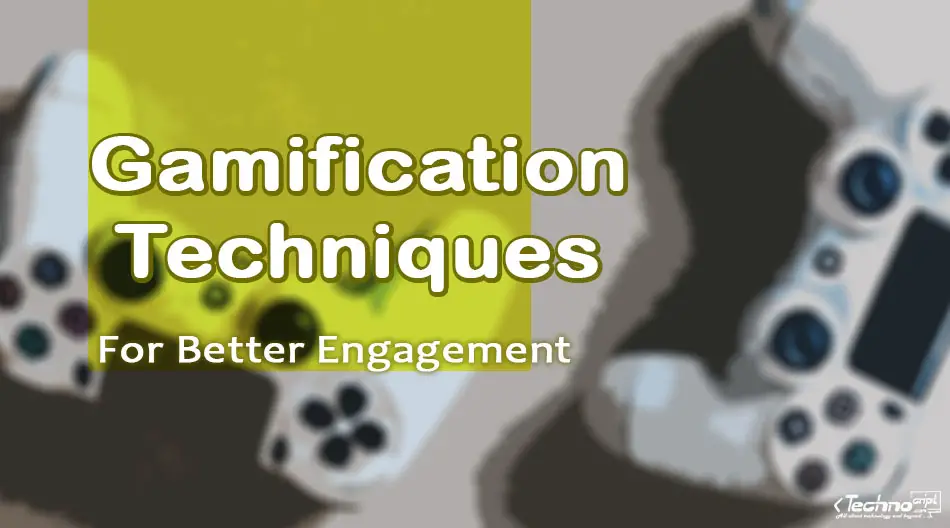A game technique is a set of rules with the potential to motivate players to interact with games. It represents the interactivity asset of any gamified context.
We describe here 17 game elements we might find in games and re-use them as gamification techniques in other gamified applications.
1. Overview
Gamification is the use of techniques derived from games in other non-game contexts, to solve problems related to interactivity and engagement.
On the other hand, game techniques are sets of rules and feedback loops, used to motivate players to interact with games.
Game techniques have different levels of complexity and motivational capabilities. Some of them are very common and can be encountered in many games, such as points and leaderboards. While others are less common but still have their implicit engaging effects, such as stories and challenges.
2. Gamification Techniques
Due to the overlapping between gamification, games, and other concepts, there are no clear boundaries to distinguish between the game and its techniques.
In this article, we summarize 17 elements that can be considered gamification techniques.
2.1. Points
Points are one of the most important parts of any gamified system. They are local rewards being awarded for a variety of reasons, such as performing tasks and interacting with the game.
Furthermore, points are very common across the different types of games, they come in multiple forms. In most cases, points in games contribute to determining the level of the player and his/her position within the game.
2.2. Badges
Badges are rewards granted to players when they accomplish distinctive progress within the game. They are graphical representations of the player’s achievements.
For maximum benefit, Badges need to appear in the player’s profiles so they can be seen by other actors in the game. They also act as means to represent the player’s status in different parts of the game.

2.3. Leaderboards
The leaderboard is a ranked list of players according to their progress within the game. It is a technique that compares the score achieved by each player (for example number of earned points).
Leaderboards aim at creating a competitive environment where players seek to compete and outrank each other. They are great assets to promote competition and motivation in the game.
Leaderboards rely on other gamification techniques such as points to calculate the rank of each competitor. They can be also organized as per time conditions (daily, weekly, overall) or a group of related players (friends, daily active users, …).
2.4. Challenges and Tasks
Challenges and tasks are problems that players face when playing a game. To make a progress, players try to solve specific tasks and get rewards as per their results.
In most cases, challenges need to be clear and well described, so the player can easily understand their conditions and possible goals. Accordingly, challenges and tasks are missions that allow players to achieve specific goals within the game.

2.5. Levels
Levels can be seen as horizontal representations of specific aspects of the same game, where players move from one level to another based on their performance during the game.
Levels can be designed in multiple ways, there are basically two types of levels:
- Game Level: the level of challenges within the game as per their complexity.
- Player Level: the level of each player as per obtained skills and experience within the game.
2.6. Feedback
Feedback refers to the information provided by games to players, in response to their interactions and progress within the game. It is essential to maintain the user’s attention and motivation when interacting with the game system.
Feedback might be informational, which indicates the assessment of the player’s interaction. It might be also directional, which guides players to the correct interactions and possible paths to move forward.
2.7. Competition
Competition is a set of conditions that makes players strive to make progress and establish superiority over others. Most games contain multiple participants who interact with the game and compete with each other.
The ultimate goal of competition is to promote the players’ desire to achieve progress and prove their merit. It is very efficient to create an interactive and engaging environment regardless of the nature of the gamified application.
2.8. Scarcity
Scarcity is the artificial limitation of resources within a game. It might be, for example, a limitation on the number of possible interactions, or time restrictions to achieve these interactions.
Scarcity works on restricting the game conditions and challenging players to find possible paths and tricks to overcome these restrictions.
2.9. Linear and Non-linear Paths
In the game context, players follow a number of specific (predefined) paths to achieve goals and move forward in the game. Such paths can be designed in multiple ways.
The linear approach depends on building tasks in a sequential manner, defined by a specific order. In which each player must finish each task to move on to the next one.
On the other hand, the non-linear approach gives players the ability to choose the tasks they wish to solve from a set of available tasks.
2.10. Hidden Elements
Hidden elements are unexpected components being revealed to players at appropriate and carefully selected moments. This makes the game scenario unpredictable which lead to better engagement and motivation.
Hidden elements can be achieved in various ways. Tasks, rewards, badges, and many other similar elements might be hidden within the game context.
2.11. In-game Items
In-game items are resources that players can use to help them progress during the game. They work as tools that players might use to overcome a difficult task or assest them finding the solution.
In-game items can be also won as rewards or exchanged for a specific balance or score. They can be designed in multiple forms. For example, players can skip a mission, replace it with another one, or ask for help tools to solve this mission.

2.12. Rewards
Rewards are prizes given to players in recognition of their achievements when playing the game. They should be part of any gamified system as they provide great levels of user engagement and motivation.
Rewards can be in various forms, such as badges or in-game elements. They should also fit both the difficulty level of the accomplished tasks and the player’s experience in the game.
2.13. Achievements
Achievements are recognitions that highlight the activities, tasks, and challenges that a player has overcome in the game. They should appear in the player’s profile to help track his/her performance.
Achievements are pretty similar to badges, but they don’t usually imply superiority in the accomplished task. Similar to other techniques, achievements help in motivating players to continue interacting with the game and accepting more challenges.
2.14. Time-limited Activities
Time plays an important role in most games. As it stimulates players and encourages them to interact quickly to complete tasks.
Most tasks and activities in the game should be combined with time restrictions. This will motivate players to deal seriously with the challenges they face.
2.15. Progress Saving
Progress saving aims to create milestones at specific phases of the player’s interaction with the game. To help players retain their achievement so they don’t lose everything and start over each time they fail.
In a related manner, players might be also allowed under specific conditions to repeat some tasks in case of failure. All these techniques help maintain the user’s motivation and game attractiveness.
2.16. Story and Storytelling
The story is one of the most effective game techniques. It is implemented by linking tasks and challenges to each other so that they appear as a series of story events.
Along with other complementary techniques such as storytelling, stories are very effective channels to guide players to the goals they are competing for.
2.17. Social Factors
Social factors are fundamental aspects to be included in any gamified system. There are dozens of social techniques that could be combined within games, such as forums, chats, teams, comments, ratings, liking, reporting, sharing, and many others.
Social aspects work on transforming the game into a community of players. Where they share their thoughts about the game, show their achievements, and discuss their different approaches to overcoming its challenges.

3. Conclusion
In this article, we summarize 17 game elements that can be used as gamification techniques in other contexts. Some of them are pretty common and easy to recognize in many games, such as points and leaderboards. While others are less common and a bit more complex, such as story and challenge.
Although many of the mentioned techniques are overlapping, the majority can be implemented separately and achieve better engagement.

